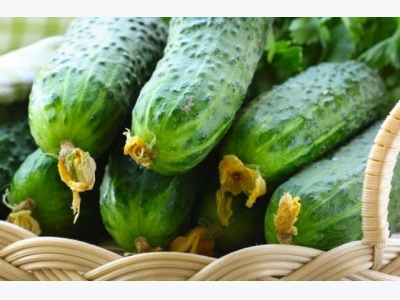How To Grow Unleavened Cucumber Crops – Read Our 9 Checked Tips!

Crispy green cucumbers in the right shape and without bitterness!
To grow such cucumbers it is not enough just to sow the seeds. It’s also important to know some other things …
Tip 1: Select a suitable variety
Try to pick such a variety of cucumbers that grow well and long fruitful in your geographical area.
You need to prefer varieties that are resistant to disease. For example, the Gergana cucumber variety will delight you with delicious fruits until the autumn. It has dark green and glossy cylindrical fruit, about 30 cm long, the flesh is light green and dense, with no bitterness. The variety “Freshness” also has a good viability.
Tip 2: Wipe properly
An important stage in cultivation, which directly depends on the quality of the cucumber crop – is watering. It needs to be adjusted according to the weather conditions. In hot weather, cucumbers should be watered daily with hot water only. If the temperature suddenly drops, watering should also be reduced. In this case, the cucumbers must have enough moisture, otherwise, the fruit will get sick.
Tip 3: Help pollination
If your plants are pollinated insufficiently, you can help them, armed only with a soft brush. With her help, transfer the pollen from the male flowers to the females. The way to distinguish between male and female colors is easy: male colors have stamens and female pistils. In the former, pollen is formed, and the second is an ovary.
If you have settled a few cucumber beds that do not bear fruit and the pollination work is not expedient, you can briefly interrupt watering. In a state of stress, cucumbers begin to form many feminine colors.
Tip 4: Remove the side branches of the plant, known as colt
Excessive growths take away the power of the plant, consume excessive amounts of nutrients and water and, as a result, produce no fruit. In order not to drain the energy of the plant, they should be removed in time until they reach a length of more than 4-6 cm. Just be careful because cucumbers have very fragile stems and you should, therefore, touch them carefully.
Usually, one hand holds the stem and the other grows the growth. But if you are not skilled enough, you can use scissors.
Tip 5: Do not forget to nourish cucumbers
During the season, cucumbers are fed several times. The first feeding is done 15 days after planting, the second one – at the beginning of the flowering of cucumbers, and the third and the fourth – during the mass fertilization. The point of the last feeding is to extend the cucumber fertilization period.
It is very important for cucumbers to get enough nitrogen because it helps for the normal growth of plants. Thus, the cucumber can be fed both with mineral and organic fertilizers, and it is also possible for both types to alternate.
Fully suitable for feeding cucumbers are grass slurries or granulated poultry manure. To prepare grass, it is necessary to pour 1 kg of grass or compost with 20 liters of water and leave to stay for a few days. With this tool, you can water cucumber beds – in a capacity of 10 liters (bucket) per 1 square meter of soil.
The granulated poultry manure should be flooded with 1:10 water and allowed to stand within one week. Then 1 liter of the resulting liquid should be diluted in 10 liters of water. When you plant the plants with it, make sure the nourishing solution does not fall on the leaves.
Tip 6: Increase the concentration of carbon dioxide in the greenhouse
If you grow the cucumbers in a greenhouse, it is advisable to increase the concentration of carbon dioxide, which contributes to better plant growth. To do this, just put a bucket in the greenhouse with an animal
Fertilizer. Cucumbers also grow well when mulching the soil with fresh fertilizer, which increases the concentration of carbon dioxide in the greenhouse. The layer of mulch must be at least 3-5 centimeters thick.
Tip 7: Mulch the plants
Cucumbers can also be mulched with other materials: humus, peat, sawdust, straw. They will help you keep moisture in the soil for a longer period of time and enrich it with nutrients. At the same time, the need for watering cucumbers will be less.
Tip 8: Periodically loosen the soil
The soil around the cucumbers is advised to rummage after every rain or watering. You can simply loosen it with a cottage by digging the soil at a depth of 3-4 cm. This is necessary to ensure the breath of the roots of the plant.
Tip 9: Feed the cucumbers with milk
Some gardeners successfully practice dairy cucumber feeding. Every 2 weeks the plants are watered with water in which milk is added in a ratio of 1 liter of milk to 10 liters of water. Such watering significantly accelerates the growth of plants.
Related news
 How To Pick The Perfect Watermelon: 5 Key Tips From An Experienced Farmer!
How To Pick The Perfect Watermelon: 5 Key Tips From An Experienced Farmer! A slice of juicy watermelon, for example, is a great option for those who want to cool off. However, we know that not all markets the watermelon is really tasty
 Why Did Not The Onion Protect The Carrots?
Why Did Not The Onion Protect The Carrots? Sow the onions, as expected, through the carrot row, but the carrot fly severely damaged the shoots. Why did not the protection work?
 Why lettuce is useful
Why lettuce is useful Lettuce commonly used as the main ingredient in the salad “Caesar”. It can be combined very well with a variety of products. It may be consumed with olive oil